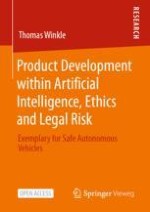Open Access 2022 | Open Access | Buch

Product Development within Artificial Intelligence, Ethics and Legal Risk
Exemplary for Safe Autonomous Vehicles
verfasst von: Thomas Winkle
Verlag: Springer Fachmedien Wiesbaden
Open Access 2022 | Open Access | Buch

verfasst von: Thomas Winkle
Verlag: Springer Fachmedien Wiesbaden
This open-access-book synthesizes a supportive developer checklist considering sustainable Team and agile Project Management in the challenge of Artificial Intelligence and limits of image recognition. The study bases on technical, ethical, and legal requirements with examples concerning autonomous vehicles. As the first of its kind, it analyzes all reported car accidents state wide (1.28 million) over a 10-year period. Integrating of highly sensitive international court rulings and growing consumer expectations make this book a helpful guide for product and team development from initial concept until market launch.